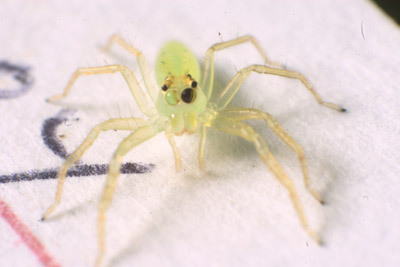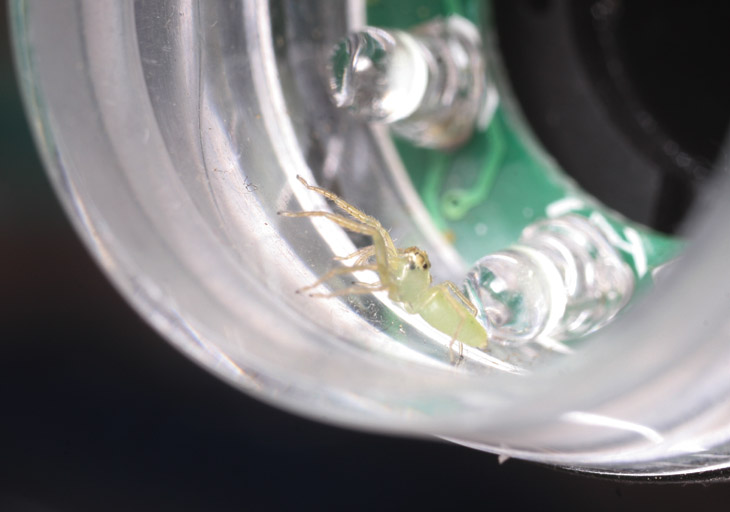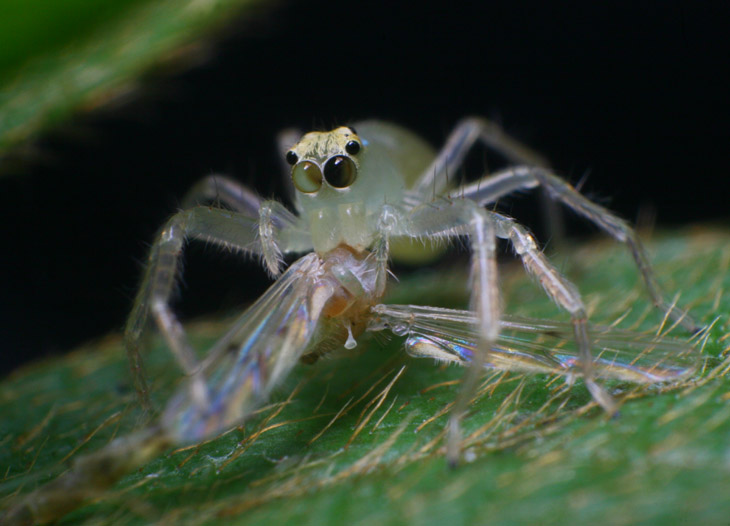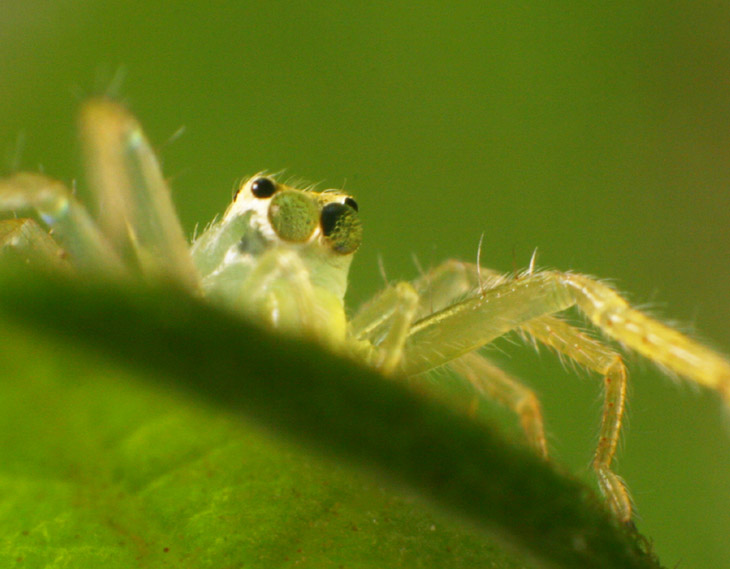I mentioned in the previous post that I made a pooter, which I’d needed for a while, but there was a specific motivation for it. A few days ago I had found another magnolia green jumping spider (Lyssomanes viridis) and I was frustrating myself trying to accomplish something that’s been on my mind since the first time around.
 Magnolia greens are the only species I’ve found that allows one to see the internal workings of the eyes without dissection, because their exoskeleton is so translucent. But they’re a small spider, even more so when only a nymph as the last few that I’ve captured, so seeing this takes some significant magnification – the image here was taken on a standard 3×5 index card, and that’s part of my writing that’s visible. I use fine-point pens, by the way…
Magnolia greens are the only species I’ve found that allows one to see the internal workings of the eyes without dissection, because their exoskeleton is so translucent. But they’re a small spider, even more so when only a nymph as the last few that I’ve captured, so seeing this takes some significant magnification – the image here was taken on a standard 3×5 index card, and that’s part of my writing that’s visible. I use fine-point pens, by the way…
With the stop-motion animation hyperactivity of jumping spiders, and the extremely short focus at high magnifications, and the flash recharge times, even getting a couple of sharp images is challenging, much less a sequence illustrating the eye motion. But since the last time I worked with one of the species, I obtained a simple USB microscope capable of capturing video, and there was no way I could let this pass. And so began the saga.
I set up a small leafed branch in the macro clamp (read: soldering jig) and placed that within a broad shallow pan filled with water, to discourage escapes. I tried a few photo sequences, but the spider was incapable of holding still long enough for a few shots in a row, even though the flash was recharging within 3 seconds or so. So after I got a few keepers, I moved the ‘stage’ near my computer and got out the USB microscope, which handily provided its own ring of LEDs for illumination.

Jumping spider are often nigh fearless, and leaning in close is usually just an invitation to leap aboard, as numerous people on YouTube have discovered. I had to retrieve previous specimens from the camera lens countless times – once on it, they had a grand old time playing keepaway as I tried to transfer them back to my stage – and the USB camera was far more appealing. I struggled to find that balance point between ‘close enough to see detail’ and ‘far enough to discourage jumps’ without ever actually finding it.

This is my photo subject sitting inside the front collar of the USB microscope for the umpteenth time; you can see the standard-sized LEDs immediately behind. So, I decided I might try another technique that I’d seen previously, and this is where the pooter came in.
When feeding, spiders naturally enough stop twitching around and hold still, so if I could produce a meal for the arachnid, perhaps I could get it to stay still and ignore the deliciously-inviting camera. Insects that can provide a meal for a 4mm spider are a pretty specific size, and not one that can be caught easily; thus the pooter. With the assistance of the porch light last night, I captured several choice bugs and loosed them within a small terrarium, actually finding another magnolia green while I was at it. The terrarium also held the branch and macro clamp, to encourage the spiders to do their feeding thereon and make my job easier. Not surprisingly, the spiders and their potential meals all seemed more interested in marching around on the sides of the terrarium instead. However, after several hours of checking from time to time, I finally peeked in to find that one of the spiders had snagged a midge. And miraculously, it had done so while perched on a leaf.

Gently, I took the whole rig out of the terrarium and set it on my computer desk next to the USB microscope. There were a few tense moments (tense in the life of an arthropod photographer – not exactly gripping) as I tried to convince the spider to turn towards the camera more because I didn’t have a good face view past a leaf, and the spider showed signs of abandoning its prey, but it turned to face the right way and, by gum! I got the video I was after. It’s not half as close as I can manage with the SLR, and for some reason it seemed to be recording at accelerated speed so had to be slowed back down, but now you can see just how weird the wandering eyes look.
The midge is roughly the size of a mosquito, if that helps generate an idea of scale. The magnification of the corneas gives a surreal ‘floating’ appearance to the retinas behind them, and this can even be seen without magnification, though it helps to be really nearsighted – it’s disconcerting, to say the least, because you’re focused on the spider’s head but the eyes look closer. It doesn’t show so well in the photos because the depth is so short and I was focusing on the facial features instead. But you gotta love that Lurch haircut…

Now, yes, I know that several newer DSLRs now have video capability, but there are a few reasons why I’m not pursuing that avenue. The first is, I have only occasional use for it – two or three times a year. Second, macro focus is so short that a tripod is absolutely necessary unless you want to see video that continually wanders in and out of focus and induces motion sickness to boot. And in most of my uses, a tripod is simply not a viable option – many times I’m leaning over a bush or crouched to get a specific angle. Third, video work isn’t done with strobes, but with constant light sources, which have to be quite bright – this pretty much means expensive batteries or an AC power source, also limiting how and where video can be done. And finally, it’s several hundred dollars in expense, and I generally treat photo expenses as investments whenever possible. If it’s not going to bring in more income, it’s not an expense worth making.

Overall, though, I’m pleased with how well this trick worked, and after a frustrating session a few days ago during the first attempt, this one went surprisingly smoothly. I figure I’m due occasionally.

Right now I’m trying to decide if I will release the two jumping spiders, or try to maintain the terrarium as a habitat and let them grow to adulthood. Both are females (the pointy pedipalps are a giveaway) so they won’t be breeding unless I find a male too, but having bigger models to work with would certainly be a plus.
I’ll leave you with one of the photos from the previous session, because the oblique angle produced another weird effect that I liked, almost appearing to be ‘shopped. Definitely interesting.






















































One thought on “Keep coming back to ’em”
Comments are closed.